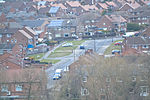Hellaby
Civil parishes in South YorkshireGeography of the Metropolitan Borough of RotherhamOpenDomesdayUse British English from July 2016Villages in South Yorkshire

Hellaby is a village and civil parish in the Metropolitan Borough of Rotherham, South Yorkshire, England. The population of the civil parish at the 2011 census was 825. It is situated 5 miles (8.0 km) east from the centre of Rotherham and forms a continuous urban area with Maltby, separated from the rest of Rotherham by Junction 1 (Bramley Interchange) of the M18. It is situated by Hellaby Brook and, whilst signposted as "Hellaby Village", the parish has no school, church or post office.
Excerpt from the Wikipedia article Hellaby (License: CC BY-SA 3.0, Authors, Images).Hellaby
Lowton Way,
Geographical coordinates (GPS) Address Nearby Places Show on map
Geographical coordinates (GPS)
| Latitude | Longitude |
|---|---|
| N 53.425 ° | E -1.2449 ° |
Address
Lowton Way
Lowton Way
S66 8HR
England, United Kingdom
Open on Google Maps







